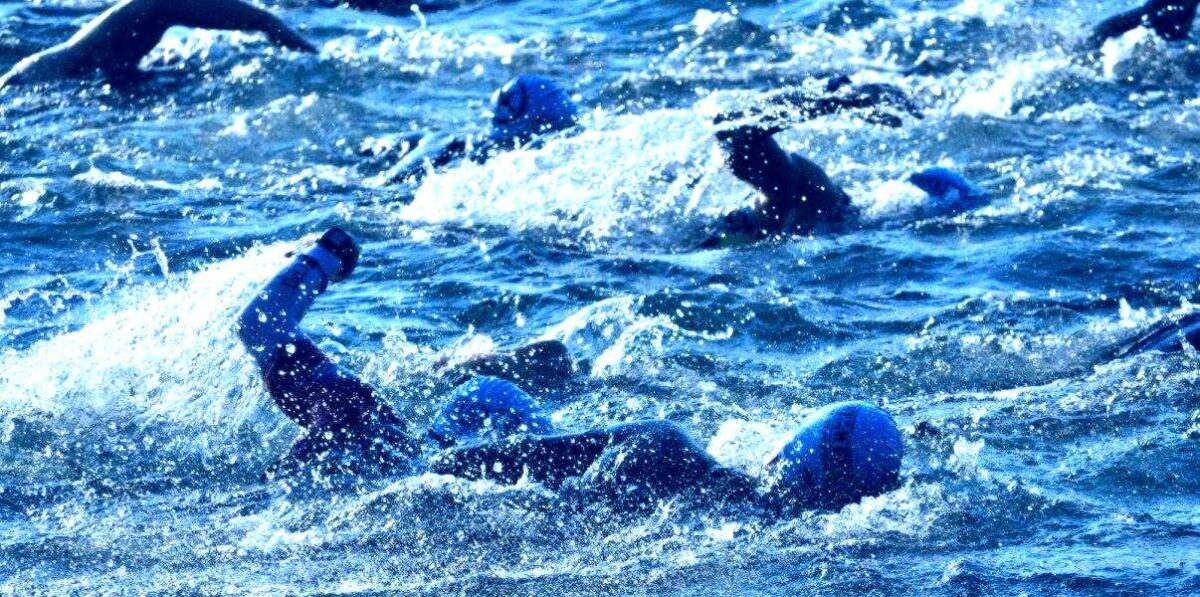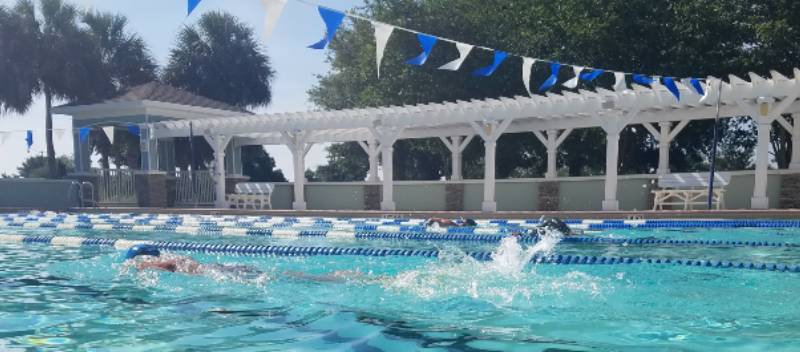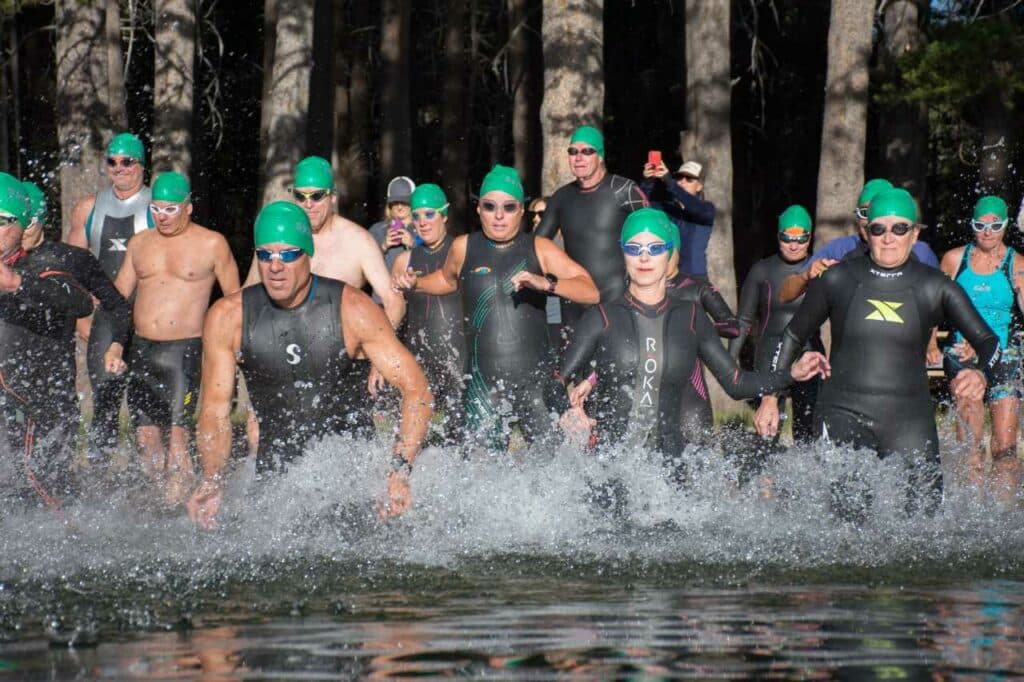Becoming a Confident Open Water Swimmer

Lack of confidence in swimming in open water is one of the top reasons seniors give for not doing a triathlon. This post contains advice from other seniors who have overcome their fear of open water swimming to finish many triathlons and open water swim races.
Background
In early 2021, I conducted a survey about triathlon’s greatest challenges for seniors, both beginners and experienced triathletes. Nearly one of four respondents identified concern about the swim as a challenge.
My recent conversation with Pat and Joan Hogan about their triathlon journeys reminded me of this statistic. Fortunately, many seniors, including Joan Hogan, have “slain that dragon” to go on and compete in triathlons.
How have they done this?
Approach
I asked three experienced senior triathletes who previously struggled with the open water swim how they had become more confident in open water. The three who generously and openly shared their experiences and advice, making this post as insightful as it is, are (in alphabetical order of last name):
- Nikki Austin, Virginia Beach, Virginia
- Donna Maguire, The Villages, Florida
- Paul Zellner, Chicago, Illinois
Here is what I heard them say.
Some Discomfort With Open Water Swimming Is Normal
“You are not alone” was a common phrase I heard during my conversations with Nikki, Donna, and Paul.
The first step is to realize that some anxiety about open water swimming is normal. Truthfully, fear is beneficial when it causes us to avoid self-destructive actions and unnecessarily dangerous situations.
Donna recalled watching from a boat the swim leg of a half Ironman triathlon whose swim was in Savannah River. She was amazed to see the number of triathletes who were on their back, hanging onto a kayak (which is allowed by USAT rules), or showed other signs of struggling.
Swimming is the most technical of the three disciplines of a triathlon. While it requires fitness and endurance, the technique, which includes how your hands and arms enter the water and your posture throughout the stroke, is key to a comfortable swim.
Ways to Develop More Confidence as an Open Water Swimmer
Nikki, Donna, and Paul prove you can become a confident open water swimmer.
What is the secret? Following is the picture they painted as they related their experiences.
First, Become Confident in the Pool
The three contributors to this post each mentioned the need to become confident swimming in a pool before heading into the open water.
What this will require depends on your experience with swimming. Some, who never learned to swim as a child, will need to start from the beginning, often with lessons. (If you are starting from the beginning, the first goal is to learn proper breathing.)
Others will develop confidence by swimming with a Masters swim or triathlon club. For others, hiring a swim coach to help them develop a more efficient swim stroke or kick will be the answer.
Paul said that when he was learning to swim, putting on flippers helped him to get enough forward momentum that he could focus on coordinating his arm movement and breathing. Once breathing during the swim stroke felt natural and relaxed, he put the flippers aside and focused on kicking.
Practice Sighting in the Pool
Once you enter the open water, you will no longer have the lines at the bottom of the pool to follow. So, while you are still in the pool, begin to practice ‘sighting‘.
Sighting is an essential part of the open water swim stroke during which you lift your head out of the water to check your location and surroundings. During a triathlon, proper sighting will keep you on the shortest course to the next turn buoy or to the swim exit.
Stay Focused
Even as you develop confidence in the pool, remember to stay focused on what you are trying to accomplish in each session. Avoid daydreaming.
Whether you are learning to swim or training to improve your stroke, focus is key to becoming a more efficient swimmer.

Practice with race day nutrition
We often think of muscle cramps as an issue for runners. However, cramps have ended a race for many a triathlete during the swim.
While swimming in the pool, learn of any issues you have with cramps. Some people experience these in their calf or foot muscles. Others can experience them in their lower back. I remember a cramp in one of my hamstring muscles cutting a swim session short.
For most people, preventing cramps is a matter of paying attention to nutrition and hydration before a swim.
Being adequately hydrated before the swim is a must to prevent cramps. Others benefit from eating a banana (potassium) or taking an anti-cramp supplement (e.g. GU gel with electrolytes, Hammer Nutrition Endurolytes) thirty minutes before swimming.
Next, Practice in Open Water
Your next goal is to swim in the open water.
A first principle of triathlon is “never do anything for the first time on race day”. This is especially true for open water swimming.
Start with a short distance. However, aim at eventually swimming a distance at least two times that required in your next triathlon.
If possible, complete this swim in different weather and water conditions. For example, don’t swim only if the water is calm. Practice swimming with wind and more choppy weather. You should even practice sighting with the sun in your eyes, a common situation during early morning races.
If the race will be in the ocean, practice getting past the breaking waves near shore by swimming through them.
Get the Right Gear
Arming yourself with a few items can eliminate some common sources of anxiety. Others can make you more visible while you are sharing the open water with boats and personal watercraft.
Besides a pair of good fitting goggles, including one pair with tinted lenses for those times when you are swimming into the sun, two must-have items for open water swim practice are:
While more expensive than these two items, a triathlon wetsuit is another wise investment. A wetsuit is great when the water or air temperature is cold. In addition, it adds buoyancy to keep your legs at the top of the water, making this one less thing with which to concern yourself.
Join Others to be More Confident as an Open Water Swimmer
When you first swim in open water, do so with other people. If possible, find a triathlon or swim club. If this doesn’t work because of where you live, find a place where experienced swimmers go, such as a public beach, and go with a friend.
Swim only in areas where swimming is specifically allowed. Swimming in “any old place” can mean swimming with unfriendly critters such as alligators, snakes, and jelly fish.
An ideal place to swim is at a public beach with lifeguards. According to the United States Lifesaving Association (USLA), the chance of a person drowning while at a beach protected by USLA affiliated lifeguards is 1 in 18 million.
Swim back and forth between lifeguard towers or, if there is only one, within the distance the single lifeguard covers. You can even inform the lifeguard of your situation.
Then, if possible, swim in water no deeper than that in which you can stand. This will eliminate another possible source of anxiety.
Ways to Maintain and Even Build Confidence in Open Water Swimming
Even after you have become confident in the open water, it is essential that you follow safe practices.
Nikki told me that before she heads out for a swim in the ocean or nearby Chesapeake Bay, she checks the surf forecast for the beach at which she plans to swim. In particular, she looks at the forecast for rip currents and wave height.
“I might still swim if there are waves a couple of feet, maybe more, but that changes the dynamics of the swim. I might not swim a mile but will be happy to work on my sighting, breathing, and other skills. I have actually found it to be quite fun and inspiring to see my skill level increase when swimming in more challenging water conditions.”
To learn more about rip currents, how to identify them, and how to swim in water where they are present; watch this short but information-packed video presentation by a representative of the National Weather Service.
Nikki’s comments on the benefit of swimming in different weather conditions and bodies of water (lakes, rivers, ocean) were echoed by Donna and Paul.
Other advice from the three for growing your confidence in the open water is:
- Swim in open water every opportunity you have.
- Continue to improve your swim fitness and technique. Learn to swim more efficiently. This does not have to mean swimming faster, but with less effort, using less energy because you are more efficient. Feeling out of breath, on the other hand, can bring on panic.
- Finally, train yourself to mute any negative voices in your head. Some swimmers count from 1 to 100 over and over. Others sing. Do what works for you to stay calm.
“Do the thing you fear to do and keep on doing it… that is the quickest and surest way ever yet discovered to conquer fear.”
Dale Carnegie
Race Day Tips
Race day can present its own challenges. There is the almost inevitable contact with other swimmers. A race can also unleash an adrenaline-driven desire to keep up with or pass other racers.
Ways to mitigate these are:
- If possible, swim in the open water of the race in the minutes leading up to the start of the race. This falls into the category of minimizing surprises that can come from:
- Knowing the condition of the water in which you will walk into and swim. Are there sharp or slippery rocks on the way into the water? Are there weeds that I will touch when swimming? How quickly does the bottom drop-off?
- Kick-starting your heart rate. If your heart rate spikes when starting fast, a pre-race swim will help prevent this.
- Getting wet. The pre-race swim gets any shock of first entering the water out of the way before the race starts.
- If there is a wave start, position yourself to one side of other swimmers or at the back of the pack.
- Find and get into a rhythm as quickly as possible and stick to it. Stay calm. Nothing goes well when you tense up. This is just as true for swimming as it is for other sports.
- Try to swim near others you can follow. As long as they stay on course, you can follow them, which reduces the amount of sighting you must do.

Resources for Becoming a More Confident Open Water Swimmer
Nikki, Donna, and Paul told me of the resources they have found helpful in becoming and staying confident while swimming in the open water.
- Effortless Swimming on YouTube
- Tower 26 swim coach podcast
- I Race Like a Girl triathlon club and podcast
- Total Immersion Swimming
Thank You
Thank you to Nikki, Donna, and Paul for sharing your time and insights that are the basis for this post.
If you found this article useful, please add a Comment to thank them.
Is There More You Need to Know to Become a Confident Open Water Swimmer?
What questions do you have? Are there other tips you have learned for becoming a more confident, open water swimmer?
Or, have you found other resources for developing confidence in the swim leg?
Comments: Please note that I review all comments before they are posted. You will be notified by email when your comment is approved. Even if you do not submit a comment, you may subscribe to be notified when a comment is published.

Thank you for the informative article. I have been a runner throughout my adulthood and recently took up biking. I tried swimming several years ago and absolutely panicked during the swimming part of my first sprint triathlon.
This article inspires me to try it again by starting out with some much need swim lessons.
Thank you Melinda for your comment. Let us know how we can help with the swimming and how you are progressing.